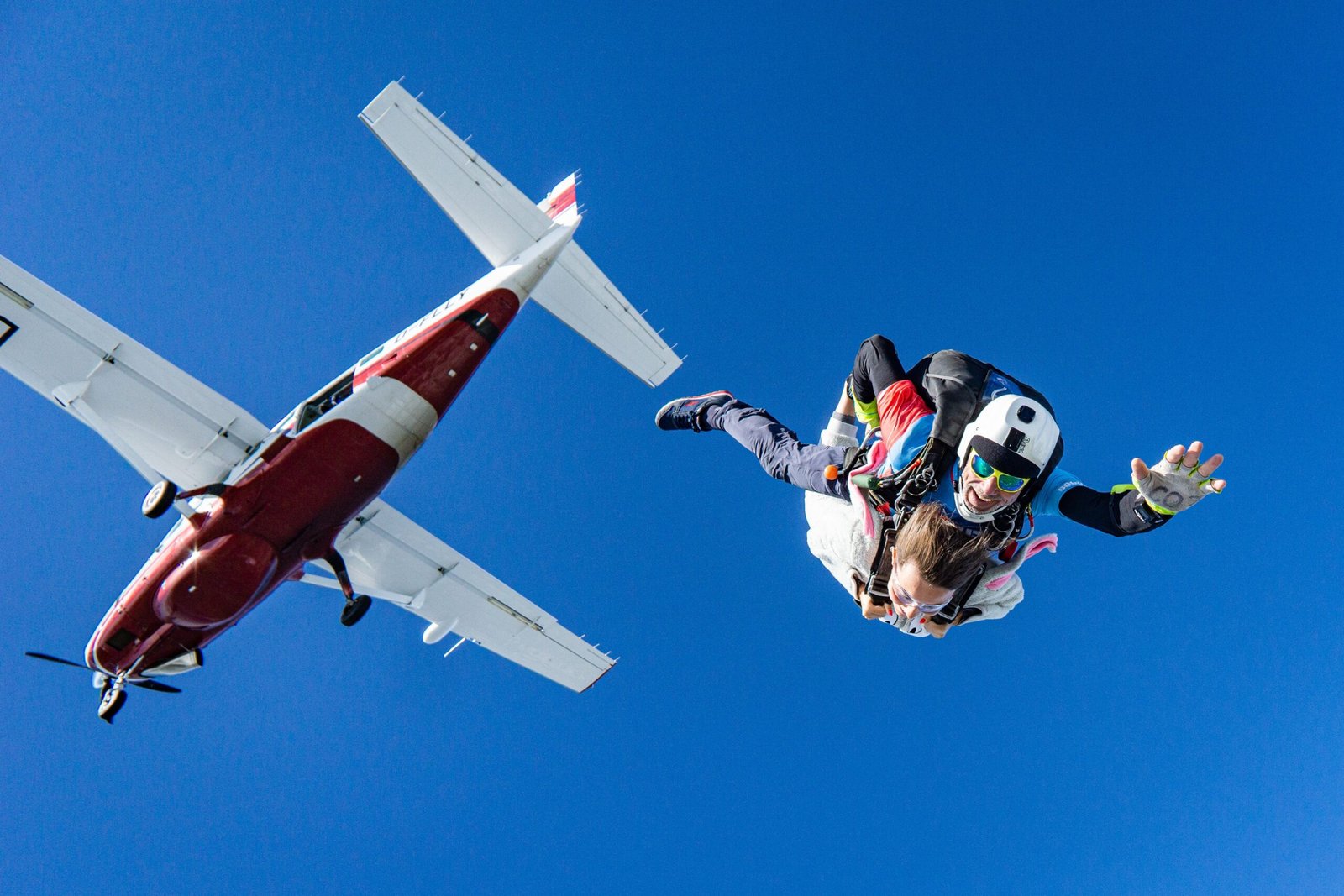Tandem Skydiving
Tandem Skydiving: Your Ultimate Guide
Ever looked up at a plane and thought, “I wonder what it’s like to jump out of that?”
Yeah, me too.
Tandem skydiving is one of those experiences that sits on many people’s bucket lists.
I’m going to break down everything you need to know about it, especially if you’re thinking about jumping at Skydive Tilstock Freefall Club.
What is Tandem Skydiving?
Let’s get the basics straight.
Tandem skydiving is where you’re securely harnessed to a highly experienced instructor.
You jump together.
They handle the technical stuff.
You get the pure adrenaline rush.
It’s the easiest and safest way to experience freefall.
Why Choose Tandem Skydiving?
Why not go for it?
But seriously, there are some solid reasons why people choose tandem skydiving:
- No prior experience needed: You don’t need any training beforehand.
- Quick and easy introduction to skydiving: It’s the perfect first jump.
- Maximum thrill with minimal effort: You get the full experience without the learning curve.
- Overcome fears: Many people use it to conquer their fear of heights.
- Create unforgettable memories: It’s an experience you’ll never forget.
It’s about pushing your boundaries and doing something extraordinary.
Tandem Skydiving at Skydive Tilstock Freefall Club
Skydive Tilstock is a great place to do your tandem skydive.
Here’s why:
- Experienced instructors: They have a team of highly qualified and experienced instructors.
- Great location: It offers stunning views of the Shropshire countryside.
- Friendly atmosphere: It’s known for its welcoming and supportive environment.
- Focus on safety: They prioritise safety above all else.
They also have some great events throughout the year.
Events at Skydive Tilstock Freefall Club
Skydive Tilstock isn’t just about making jumps.
They have a buzzing community and regularly host events.
These can include:
- Boogie weekends: These are social gatherings for experienced skydivers.
- Formation skydiving camps: For those looking to learn more advanced skydiving skills.
- Charity events: Opportunities to raise money for good causes while skydiving.
Check their website or social media for the latest schedule.
Charity Tandem Skydiving
Tandem skydiving is a fantastic way to raise money for charity.
Here’s how you can do it:
- Choose a charity: Pick a cause you’re passionate about.
- Set up a fundraising page: Use online platforms like JustGiving to collect donations.
- Promote your skydive: Tell your friends, family, and colleagues about your fundraising efforts.
- Complete your skydive: Celebrate your achievement and the money you’ve raised.
It’s a win-win: you get an incredible experience and support a good cause.
A Step-by-Step Guide to Your Tandem Skydive
Let’s walk through what you can expect on the day of your tandem skydiving adventure:
- Booking: Book your jump in advance, especially during peak season. Book Now Button at top of page.
- Arrival and Check-in: You’ll arrive at the dropzone, fill out paperwork, and get weighed.
- Ground Training: You’ll receive a briefing from your instructor covering safety procedures, body position during freefall, and landing techniques.
- Gearing Up: You’ll be fitted with a harness that connects you to your instructor.
- Aircraft Ascent: You’ll board the aircraft and enjoy the scenic flight to jump altitude.
- The Jump: You and your instructor will exit the aircraft together.
- Freefall: You’ll experience the thrill of freefall for around 45-60 seconds, reaching speeds of up to 120 mph.
- Parachute Deployment: Your instructor will deploy the parachute.
- Parachute Ride: You’ll enjoy a scenic descent under the parachute, with stunning views of the surrounding area.
- Landing: Your instructor will ensure a safe and smooth landing.
It’s a well-orchestrated process designed for maximum safety and enjoyment.
What to Expect During Your Tandem Skydive
Here’s a more detailed look at what you’ll experience during each phase of your tandem skydive:
- The Plane Ride: It’s a mix of excitement and anticipation as you climb to altitude.
- The Exit: This is the most intense part. You’ll feel a rush of adrenaline as you leave the plane.
- Freefall: It’s unlike anything you’ve ever experienced. It’s a sensation of pure freedom.
- Under Canopy: The parachute ride is surprisingly peaceful. You can chat with your instructor and enjoy the view.
- The Landing: It’s usually a soft landing, but you might need to lift your legs.
It’s a sensory overload in the best possible way.
Addressing Common Concerns About Tandem Skydiving
People have questions and concerns, which is totally normal.
Here are some of the most common ones I hear about tandem skydiving:
- Is it safe? Yes, tandem skydiving is very safe when conducted by experienced professionals at reputable dropzones.
- What if I’m scared of heights? Many people who are afraid of heights enjoy tandem skydiving. The freefall sensation is different from standing on a high ledge.
- What should I wear? Comfortable clothing and closed-toe shoes are recommended.
- Can I bring my phone or camera? Usually not during the jump itself, but most dropzones offer professional photo and video packages.
- What if the weather is bad? Skydiving is weather dependent. If it’s unsafe to jump, you’ll be rescheduled.
It’s about managing risk, not eliminating it, but the safety record of tandem skydiving is excellent.
Making the Most of Your Tandem Skydiving Experience
Want to make your tandem skydiving experience even better?
Here are a few tips:
- Book the video and photo package: You’ll want to relive this moment.
- Bring friends and family to watch: Sharing the experience with loved ones makes it even more special.
- Relax and enjoy the moment: Don’t overthink it. Just go with the flow.
- Ask questions: Don’t hesitate to ask your instructor any questions you have.
This isn’t a dress rehearsal. It’s the real deal.
Tandem Skydiving: Final Thoughts
Tandem skydiving is an incredible experience.
It’s a chance to step outside your comfort zone, experience something truly unique, and create memories that will last a lifetime.
If you’re considering it, I say go for it.
You won’t regret it.
Frequently Asked Questions (FAQs)
- Q: How much does a tandem skydive cost? A: Prices vary by location and dropzone, but you can expect to pay between £250-£300 in the UK.
- Q: What is the minimum age for tandem skydiving? A: Usually 16, but this can vary by dropzone.
- Q: Is there a weight limit? A: Yes, for safety reasons. Check with the dropzone for their specific limits.
- Q: How long does the whole experience take? A: Plan for several hours, including check-in, training, and the jump itself.
- Q: What if I wear glasses or contact lenses? You can usually wear them, but check with the dropzone for their policy.

Tandem Skydiving: A Journey of Innovation and Adventure
Tandem skydiving, the exhilarating experience of freefalling from an airplane attached to an experienced instructor, has revolutionized the sport of skydiving, transforming it from a specialized military training technique into a widely accessible recreational activity. Its history is a testament to human ingenuity, safety advancements, and the pursuit of extraordinary experiences.
Military Origins and Early Development
The concept of tandem skydiving can be traced back to the 1960s, when instructors were tasked with dropping non-parachutist personnel in tandem with soldiers during military training exercises. These early attempts were rudimentary,involving a basic harness system that connected the instructor and jumper, but they laid the groundwork for the development of a more sophisticated system.
The Tandem Harness: A Breakthrough Innovation
In the late 1970s, Strong Enterprises, a skydiving equipment manufacturer, introduced a groundbreaking innovation – a tandem harness that securely and comfortably connected two individuals. This breakthrough opened up new possibilities for skydiving, making it accessible to a broader audience beyond experienced military personnel.
The Dawn of Tandem Skydiving
The early 1980s marked the official recognition of tandem skydiving, as the Federal Aviation Administration (FAA) granted it experimental status, allowing limited operations. This paved the way for the sport’s rapid growth, as skydiving centers worldwide began offering tandem jumps to thrill-seekers of all ages and experience levels.
In 1994, the British Parachute Association Now British Skydiving established a working group to investigate the safety and instructional aspects of tandem skydiving, and after rigorous review, officially recognized the activity in 1996.
Addressing Safety Concerns and Democratizing the Sport
The development of tandem skydiving and Tandem skydiving equipment was driven by several key factors. Firstly, it addressed the safety concerns of first-time skydivers, who often lacked the experience and training to jump solo. With an experienced instructor by their side, novice jumpers could experience the thrill of skydiving without the fear of getting lost or making critical mistakes.
Secondly, tandem skydiving democratized the sport, making it accessible to a broader range of individuals beyond the highly trained military personnel. The minimal training requirements allowed anyone with a basic physical fitness level to experience the exhilaration of freefall, opening up new avenues for adventure and personal growth.
Innovation in Parachute Technology
As tandem skydiving gained popularity, it also spurred innovation in parachute design and rigging techniques. Tandem parachutes were specifically developed to accommodate the weight and maneuverability of two individuals, ensuring a safe and controlled descent. Harnesses and rigging systems were also refined to provide a comfortable and secure attachment between the instructor and the jumper, further enhancing the safety and enjoyment of the experience.
Global Phenomenon and Widespread Appeal
Today, tandem skydiving has become a global phenomenon, enjoyed by millions of people worldwide. It has become a popular choice for birthdays, Charity fund raising, Stag/Hen parties, team-building activities, and simply for the sheer joy of experiencing the breathtaking beauty of the world from above.
A Transformative Force in Skydiving
The history of tandem skydiving is a story of human innovation, safety advancements, and the pursuit of extraordinary experiences. It has transformed the sport of skydiving, making it accessible to a wider audience and offering individuals from all walks of life the opportunity to conquer their fears and experience the unparalleled thrill of freefall. As tandem skydiving continues to evolve, it remains a testament to the human spirit’s desire to explore, challenge, and expand its boundaries.
